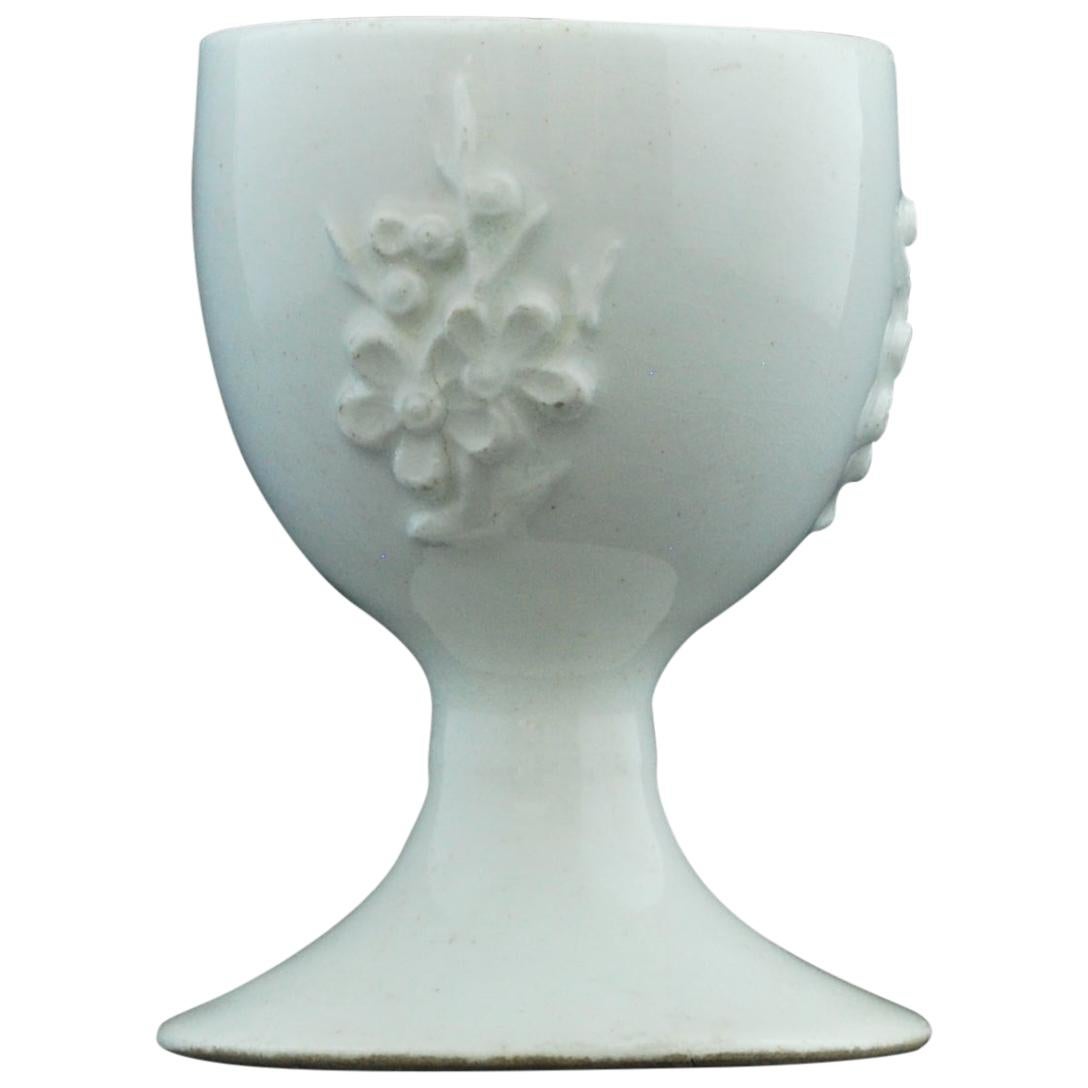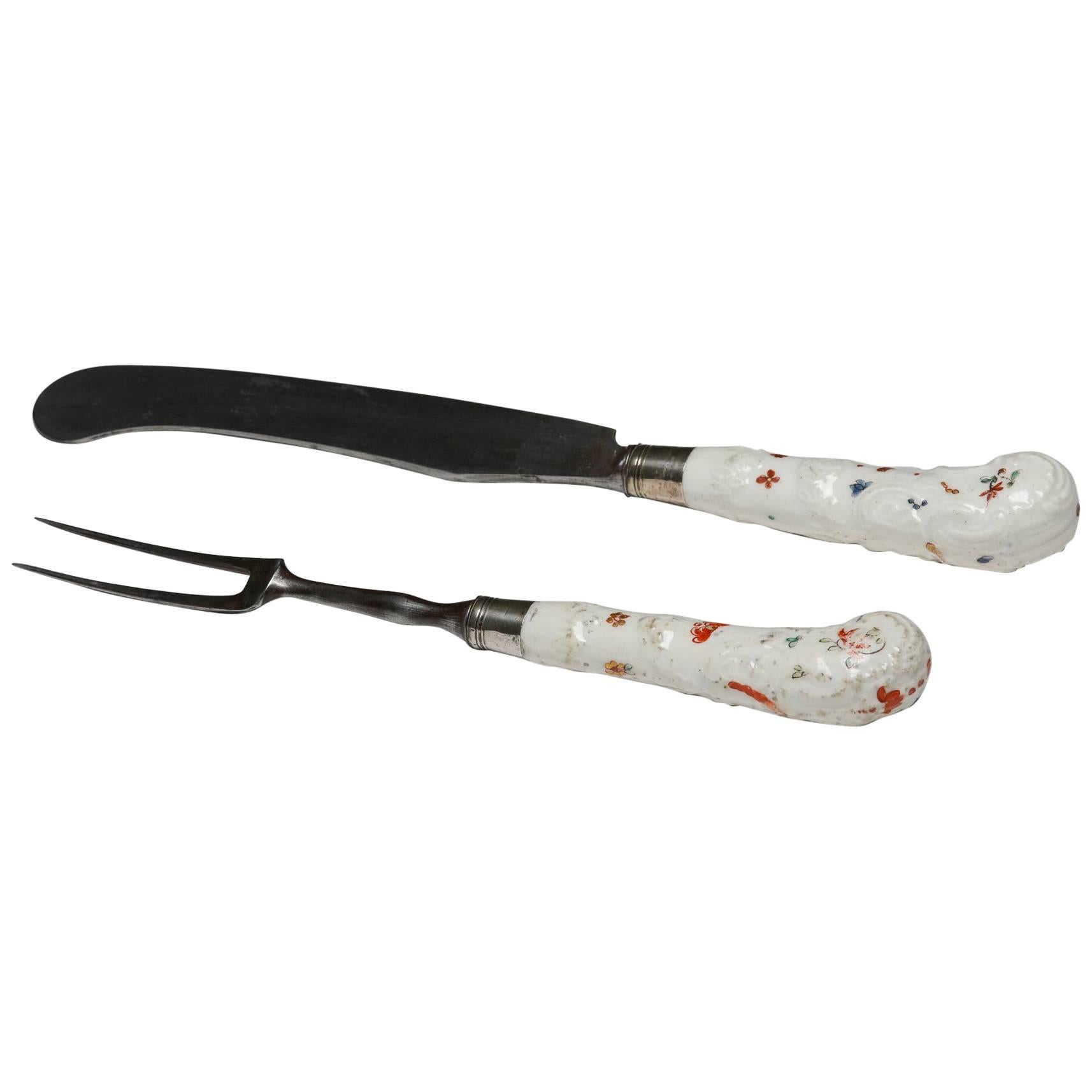Items Similar to Coffee Cup, Bow Porcelain Factory, circa 1749
Want more images or videos?
Request additional images or videos from the seller
1 of 7
Coffee Cup, Bow Porcelain Factory, circa 1749
About the Item
Of Chinese export form with loop handle; the body imaginatively painted in a bright ‘early blue’ underglaze with pine, rock and bamboo after the Chinese. Yellow tinged body; clear glaze with some blue bleeding to glaze and black speckling. Grey-green translucency. Measures: H 2.5 in (6.3 cm). Provenance: with P. and R. Daniels, Bath, 1998.
- Creator:Bow Porcelain (Manufacturer)
- Dimensions:Height: 2.5 in (6.35 cm)Diameter: 3 in (7.62 cm)
- Style:Rococo (Of the Period)
- Materials and Techniques:Porcelain,Molded
- Place of Origin:
- Period:
- Date of Manufacture:circa 1749
- Condition:Wear consistent with age and use. Glaze misses, typical of this very early manufacture.
- Seller Location:Melbourne, AU
- Reference Number:
About the Seller
5.0
Gold Seller
These expertly vetted sellers are highly rated and consistently exceed customer expectations.
Established in 2005
1stDibs seller since 2017
69 sales on 1stDibs
Typical response time: 3 hours
- ShippingRetrieving quote...Ships From: Melbourne, Australia
- Return PolicyA return for this item may be initiated within 14 days of delivery.
More From This SellerView All
- Coffee Pot, Bow Porcelain Factory, circa 1767By Bow PorcelainLocated in Melbourne, VictoriaCoffee pot, circa 1765-69: Coffee pot and cover of silver form with domed cover; the body of the pot and dome of the cover pineapple moulded between rims painted in blue with cell an...Category
Antique Mid-18th Century English Rococo Porcelain
MaterialsPorcelain
- Egg Cup, Bow Porcelain Factory, circa 1752By Bow PorcelainLocated in Melbourne, VictoriaModelled after a small Chinese blanc-de-Chine wine cup of Dehua, Fujian Province; the bowl with three single prunus sprigs. Thick glaze with some crazing around base. Green translucency. Base glazed but partially wiped. Provenance: Taylor Collection; Parkside Antiques Melbourne...Category
Antique Mid-18th Century English Chinoiserie Porcelain
MaterialsPorcelain
- Knife and Fork, Kakiemon Decoration, Bow Porcelain Factory, circa 1749By Bow PorcelainLocated in Melbourne, VictoriaAn unsually early set of handles with original steel tines and blade. Pistol grip form moulded with acanthus scrolls, leaves and swags and painted with indianische Blumen in a Kakiem...Category
Antique Mid-18th Century English Japonisme Porcelain
MaterialsPorcelain
- Covered Vase, Famille Rose Decoration, Bow Porcelain Factory, circa 1749By Bow PorcelainLocated in Melbourne, VictoriaA vase and cover, decorated with peonies &c in the Famille Rose style. Incised R mark group. Prov Taylor Collection; Simon Spero; Joseph Handley.Category
Antique Mid-18th Century English Chinoiserie Vases
MaterialsPorcelain
- Decorative Basket, Bow Porcelain Factory, circa 1760By Bow PorcelainLocated in Melbourne, VictoriaA pierced basket standing on a well-formed rococo base. Perhaps for potpourri, although the internal decoration suggests another use. We think probably oranges, chestnuts, etc. Pr...Category
Antique Mid-18th Century English Rococo Figurative Sculptures
MaterialsPorcelain
- Cup and Saucer, Kakiemon Decoration, Bow Porcelain Factory, circa 1753By Bow PorcelainLocated in Melbourne, VictoriaLow tea cup with clip handle with matching saucer, decorated after the Kakiemon with the two quail pattern. An unusual form with scarce decoration. Prov...Category
Antique Mid-18th Century English Japonisme Porcelain
MaterialsPorcelain
You May Also Like
- Bow Porcelain Orphaned Coffee Cup, Famille Rose Peony, circa 1755By Bow PorcelainLocated in London, GBThis is a very charming orphaned coffee cup made by the Bow Porcelain factory in about 1755. The cup is decorated in a Chinese "famille rose" peony pattern. This cup would have been part of a large tea service, and the tiny size shows how expensive coffee was in the 18th Century. The Bow Porcelain Factory was one of the first potteries in Britain to make soft paste porcelain, and most probably the very first to use bone ash, which later got perfected by Josiah Spode to what is now the universally used "bone china". Bow was the main competitor of the Chelsea Porcelain Factory, but where Chelsea made very fine slipcast porcelain, Bow made a different soft paste porcelain that tended to be softer and could be pressed into moulds. Bow served a larger public generally at lower prices. The factory was only in operation between 1743 and 1774, after which the tradition got incorporated into some of the later famous potteries such as Worcester and Derby. The cup is unmarked, which is normal for Bow items of this era. Condition report the cup is in excellent condition without any damage or repairs. There are various glazing imperfections, which are quite normal for porcelain of this era. Antique British porcelain...Category
Antique 1750s English Rococo Tea Sets
MaterialsPorcelain
- Bow Complete Set of Porcelain Figures "The Four Elements", Rococo, circa 1765By Bow PorcelainLocated in London, GBThis is a very rare and impressive complete set of large figures called The Four Elements, made by the Bow Porcelain factory in about 1765. It consists of Ceres representing Earth, V...Category
Antique 1760s English Rococo Figurative Sculptures
MaterialsPorcelain
- Bow Porcelain Figure of Boy or Putto on C-Scroll Base, Georgian circa 1760By Bow PorcelainLocated in London, GBThis is a wonderful little figure of a boy or putto made by the Bow Porcelain factory in about 1760. The Bow Porcelain Factory was one of the first potteries in Britain to make soft...Category
Antique 1760s English Rococo Figurative Sculptures
MaterialsPorcelain
- Bow Porcelain Figure of Venus with Doves, Rococo, 1756-1764By Bow PorcelainLocated in London, GBThis is a rare and beautiful figure of Venus with two doves, made by the bow porcelain factory between 1756 and 1764. We see Venus standing holding her robe with one hand, a flower p...Category
Antique 1760s English Rococo Figurative Sculptures
MaterialsPorcelain
- Bow Porcelain Figure of Juno with Eagle 'Jupiter', Rococo Ca 1765By Bow PorcelainLocated in London, GBThis is a very rare and impressive large figure of Juno with an eagle, made by the Bow Porcelain factory in about 1765. This figure formed part of a series of the Four Elements, with...Category
Antique 1760s English Rococo Figurative Sculptures
MaterialsPorcelain
- Bow Pair of Porcelain Figures, Arlecchino and Columbina, Rococo ca 1758By Bow PorcelainLocated in London, GBThis is a wonderful pair of figures of Arlecchino and Columbina, made by the Bow Porcelain factory in about 1758. These figures formed part of a series of the Commedia dell'Arte, a very popular series of theatrical figures that served as decoration at the dinner table in the 18th Century. The Bow Porcelain Factory was one of the first potteries in Britain to make soft paste porcelain, and most probably the very first to use bone ash, which later got perfected by Josiah Spode to what is now the universally used "bone china". Bow was the main competitor of the Chelsea Porcelain Factory, but where Chelsea made very fine slipcast porcelain, Bow made a different soft paste porcelain that tended to be softer and could be pressed into moulds. Bow served a larger public generally at lower prices. The factory was only in operation between 1743 and 1774, after which the tradition got incorporated into some of the later famous potteries such as Worcester and Derby. These figures were used to adorn the dinner table when dessert was served; groups of figures served to express something about the host, the guests, or to direct the conversation. The Italian Commedia Dell'Arte, a comical form of masked theatre, was very popular in those days and Bow copied many figures of the German Meissen series that were brought out in the decades before. This pair dates from about 1758, which was at the height of Bow's ability to make beautiful figurines often copied from Chelsea or Meissen. The pair is modelled after a Meissen pair by Kaendler. The porcelain is translucent with a beautiful milky glaze - Bow was probably the first pottery using bone in its porcelain recipe. Arlecchino (Harlequin) is playing the bagpipes, dressed in an odd costume of mismatched chintz and playing cards and wearing a funny black trumpet...Category
Antique 1750s English Rococo Figurative Sculptures
MaterialsPorcelain
Recently Viewed
View AllMore Ways To Browse
Porcelain Black
Blue Bow
Blue And Green Porcelain
Green Bow
Antique Measuring Cups
Grey Porcelain
Yellow Cup
Porcelain Coffee Cups
Chinese Silver Cup
Porcelain China Cup
Chinese Porcelain Cups
Green Glass Cup
Green Glass Cups
Chinese Porcelain Cup
Yellow Porcelain China
Antique Glass Measuring Cup
Antique Glass Measuring Cups
Yellow Chinese Porcelain





